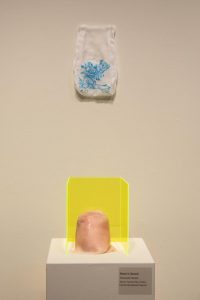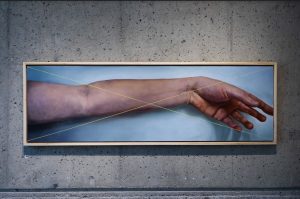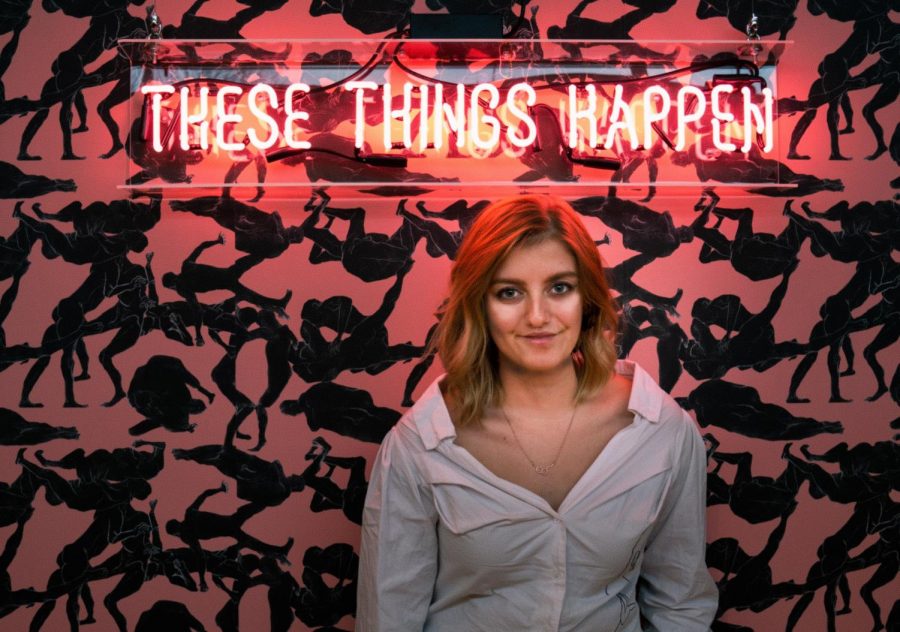Artist of the Week: Alexis Rausch
January 14, 2020
When I first saw “No Story, Thanks” by Alexis Rausch — a painting of an outstretched arm against a baby blue wall, bisected by two thin, yellow, crossed lines — I was struck by its specificity. Every detail, which I later learned where all measured strokes by the artist, fit together like puzzle pieces to display something that felt like it had a history beyond its creation. I hate to immediately use a cliché, but even though I didn’t have the language to properly articulate what I saw, the “No Story, Thanks” painting immediately offered me a thousand words.
Rausch herself, however, defies the typical “artist” cliche — she is far from a tortured genius throwing colors at a canvas to see what sticks, but she is much closer to a scientist who proposes and calculates and measures everything with complete accuracy. “I love researching and planning things out before I embark on a big project,” Rausch said. “I usually don’t have a lot of serendipitous moments where I play it by ear.” You can see that her work is immaculate, having been traced out — maybe erased — and followed through stroke after stroke, time and time again. When I went searching for more of Rausch’s pieces online, I came across a video of hers: the finishing touches to “No Story, Thanks” occur as she peels tape off the oil painting to reveal the perfect, thin line beneath — an ASMR junkie’s dream.
It’s admirable how process-oriented Rausch is, instead of geared only to the end result. “Everything is planned out really clinically. I work in a lot of different mediums even though my degree is in painting, so you have to learn about executing different processes before making a bigger piece.” Having graduated from the University of Utah last spring with a BFA, emphasizing in painting and drawing specifically, Rausch’s education informs her work. “The biggest thing I took away from my education at the U was that you really get out what you put in. If you want to progress in your practice and get a lot out of school, you need to work at it. It’s not just something that will be spoon-fed to you.” Studying in the arts was a challenge that Rausch used fully to strengthen her ability to create. Despite setbacks and health issues that loomed between her and graduation, she completed her degree and is now successfully creating. She has been featured in larger galleries and completed a residency in Ferguson, Missouri, this past summer. She immerses herself in artistic work and continues to find success.

Rausch seems to learn from everything she engages with, storing items in a mental field journal to access when she works. “I love the idea of treating even the most mundane object like an anthropological artifact that has an important history. I’m a huge history buff and collector of antiques and discarded photography, which carries over a lot into my work.” It’s true. Her pieces appear much like a collection of loved things — items she’s pondered, sparks she’s examined and treasures she’s appreciated even when others have overlooked them.
Rausch also has a beautiful way of anthropomorphizing her pieces, making them familiar in an elegant sort of way. When I asked her about her current projects, she described her interest in fabrics and all things tactile because they “beg to be touched.” An artist, a mathematician and a sociologist rolled into one, she adds, “The way we relate to tactile objects is fascinating.” Dipping her toes into this medium, her Instagram features work with rugs, needlepoint and sewing.
One of her works recently featured on-campus in the Howard Clark Exhibition in the Gittins Gallery is “Metropolol Tartrate,” a silicon mass adorned with human hair against a backdrop of embroidered organza. The creation is described by Rausch as “a replica of my father’s amputated leg to represent the beta-blockers we are both now on.” This piece carries an echo of nostalgia in its naked display of humanity, bringing memories of those we’ve lost while carrying the phrase “dust to dust.” Once again, such personal pieces are sparked by Rausch’s curiosity. “I’m very interested in memory and how/why we choose to memorialize different objects and individuals.”
Rausch’s pieces often depict individual human figures, faces and body parts often contorted — dare I say, mutilated — in ways that spark very visceral reactions. As I scroll through blurred portraits and mugshots, I’m struck again by a comic illustration: a girl with two handguns lodged in her eyes, suspended as her arms reach out to flip someone off. “I’m also very interested in the polarizing interest our society has with comfort and violence, and how we choose to internalize or project either of those states.”

Her work does what “good” art is meant to do: it challenges that state of comfort. I caught myself looking away from some images, and then knowing I needed to return to them because that’s what they are so meticulously designed to accomplish. Whether it be in paintings or textiles or even comics, Rausch reaches you in a way you don’t expect. “On the side to let off steam, I have a zine series called American Bleach Drinker that I release each year. That’s just playtime for me though!” These comics are sharper than her paintings — the shock of hard angles and contrast of dark and light juxtaposing upon her gradient canvases. “At the end of the day, though, I always come back to painting or drawing. It’s my backbone and my bread. Fills me up and keeps me safe.”
One thing I love about Rausch’s portraits, specifically, is how they are often blurred and nearly muddled. That sounds negative, but I don’t mean to imply that they are hastily done or rushed. Instead, there is a gorgeous haze that coats them, a film across a morphed face that makes you feel like an intruder on the scene. Where other pieces challenge you head-on, many of her portrait subjects don’t meet your gaze, leaving the power in your hands. They tell you that you’re the one who’s staring, so the next move is yours to make.
Rausch is not only a powerful person, but she is also an artist devoted to what her work can spark. It pushes boundaries and pulls out innate feelings, but it seeks no approval. Her work knows, just as she does, that it can support its own weight.
You can find Alexis Rausch through her Instagram, in Saatchi Gallery and in exhibits at the U.








